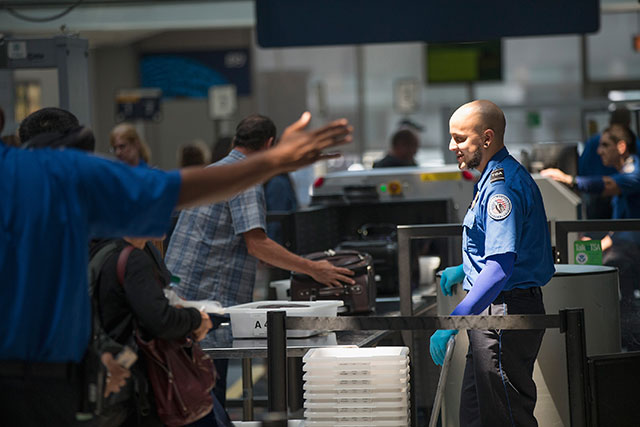
 Travelers are screened by Transportation Security Administration (TSA) workers at a security check point at O’Hare Airport on June 2, 2015, in Chicago, Illinois. The Department of Homeland Security said that the acting head of the TSA would be replaced following a report that airport screeners failed to detect explosives and weapons in nearly all of the tests that an undercover team conducted at airports around the country. (Photo: Scott Olson / Getty Images)
Travelers are screened by Transportation Security Administration (TSA) workers at a security check point at O’Hare Airport on June 2, 2015, in Chicago, Illinois. The Department of Homeland Security said that the acting head of the TSA would be replaced following a report that airport screeners failed to detect explosives and weapons in nearly all of the tests that an undercover team conducted at airports around the country. (Photo: Scott Olson / Getty Images)
The Transportation Security Administration (TSA) lacks data to demonstrate the effectiveness of several airport security measures adopted following the September 11, 2001 attacks.
A report released Monday by the Government Accountability Office (GAO) concluded that the agency “does not have a complete understanding” of just how effective the billions of dollars spent on new security programs are in detecting and disrupting air travel threats.
Although agency officials cited the lack of a major terrorist attack aboard a US airliner as proof of worth of these countermeasures, the GAO was disappointed with TSA’s lack of empirical data to justify the costly security infrastructure.
“In the absence of any systematic or methodological approach to assessing TSA’s deterrent value, TSA officials have relied on theories of causality and limited evidence available from US intelligence sources,” the report stated.
The oversight body examined six specific security programs adopted after 9/11. The review included fortifications made to passenger prescreening, airport checkpoint procedures, checked baggage inspections, bomb-detecting canines, behavioral analysis, and the US Federal Air Marshal Service (FAMS).
GAO noted that a TSA internal review in 2015 provided “mixed results” on the effectiveness of these airport security trappings.
The watchdog specifically cited classified information not included in the prior report about covert testing conducted by the TSA’s Office of Inspection, which found weaknesses in the checked baggage screening systems.
During that 2015 review, TSA didn’t document any sort of effectiveness data on two of the programs in particular: FAMS and behavioral detection.
“FAMS officials explained that they do not have information on FAMS’s deterrent effect because it is difficult to model, measure, and quantify,” GAO stated.
The report went on to note, however, that the lack of data could leave key questions about the program unanswered.
“There may be a point at which adding additional federal air marshals has diminishing returns in terms of deterrence and better understanding FAMS’s deterrent effect could help TSA identify that point,” the oversight body said.
In July of this year, GAO devoted an entire audit to the TSA’s passenger behavioral detection programs, which the watchdog concluded were based on invalid evidence. Under pressure from GAO, TSA has moved to cut finding for most of its behavioral detection activities.
GAO recommended that TSA explore ways to assess the deterrent value of its security programs. It also called on the transportation agency to conduct cost and effectiveness studies on its countermeasures.
“It is essential that TSA determine how to allocate its finite resources to best position the agency to detect, disrupt and deter threats to aviation security,” GAO urged.
The Department of Homeland Security concurred with both recommendations.
We’re not backing down in the face of Trump’s threats.
As Donald Trump is inaugurated a second time, independent media organizations are faced with urgent mandates: Tell the truth more loudly than ever before. Do that work even as our standard modes of distribution (such as social media platforms) are being manipulated and curtailed by forces of fascist repression and ruthless capitalism. Do that work even as journalism and journalists face targeted attacks, including from the government itself. And do that work in community, never forgetting that we’re not shouting into a faceless void – we’re reaching out to real people amid a life-threatening political climate.
Our task is formidable, and it requires us to ground ourselves in our principles, remind ourselves of our utility, dig in and commit.
As a dizzying number of corporate news organizations – either through need or greed – rush to implement new ways to further monetize their content, and others acquiesce to Trump’s wishes, now is a time for movement media-makers to double down on community-first models.
At Truthout, we are reaffirming our commitments on this front: We won’t run ads or have a paywall because we believe that everyone should have access to information, and that access should exist without barriers and free of distractions from craven corporate interests. We recognize the implications for democracy when information-seekers click a link only to find the article trapped behind a paywall or buried on a page with dozens of invasive ads. The laws of capitalism dictate an unending increase in monetization, and much of the media simply follows those laws. Truthout and many of our peers are dedicating ourselves to following other paths – a commitment which feels vital in a moment when corporations are evermore overtly embedded in government.
Over 80 percent of Truthout‘s funding comes from small individual donations from our community of readers, and the remaining 20 percent comes from a handful of social justice-oriented foundations. Over a third of our total budget is supported by recurring monthly donors, many of whom give because they want to help us keep Truthout barrier-free for everyone.
You can help by giving today. Whether you can make a small monthly donation or a larger gift, Truthout only works with your support.